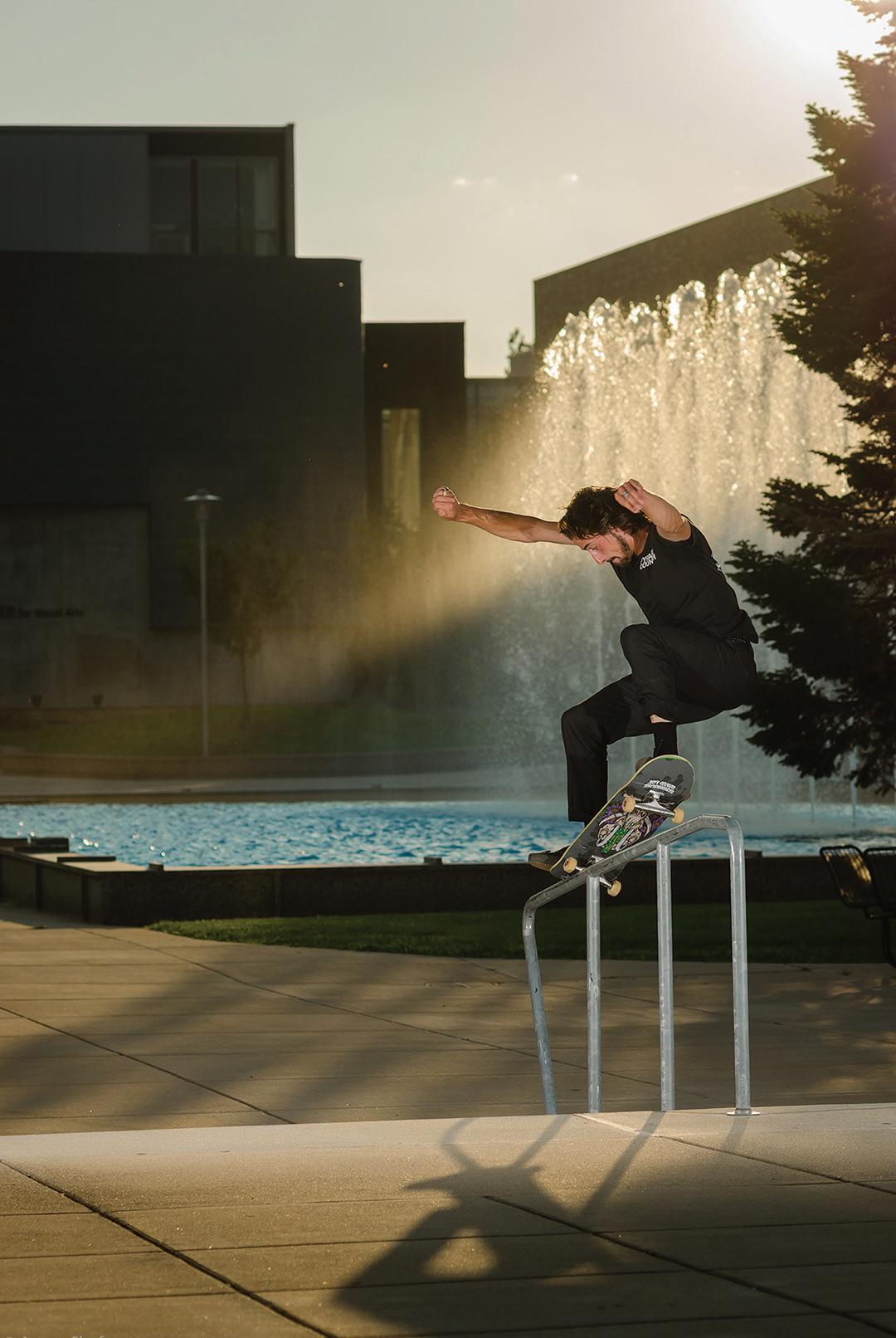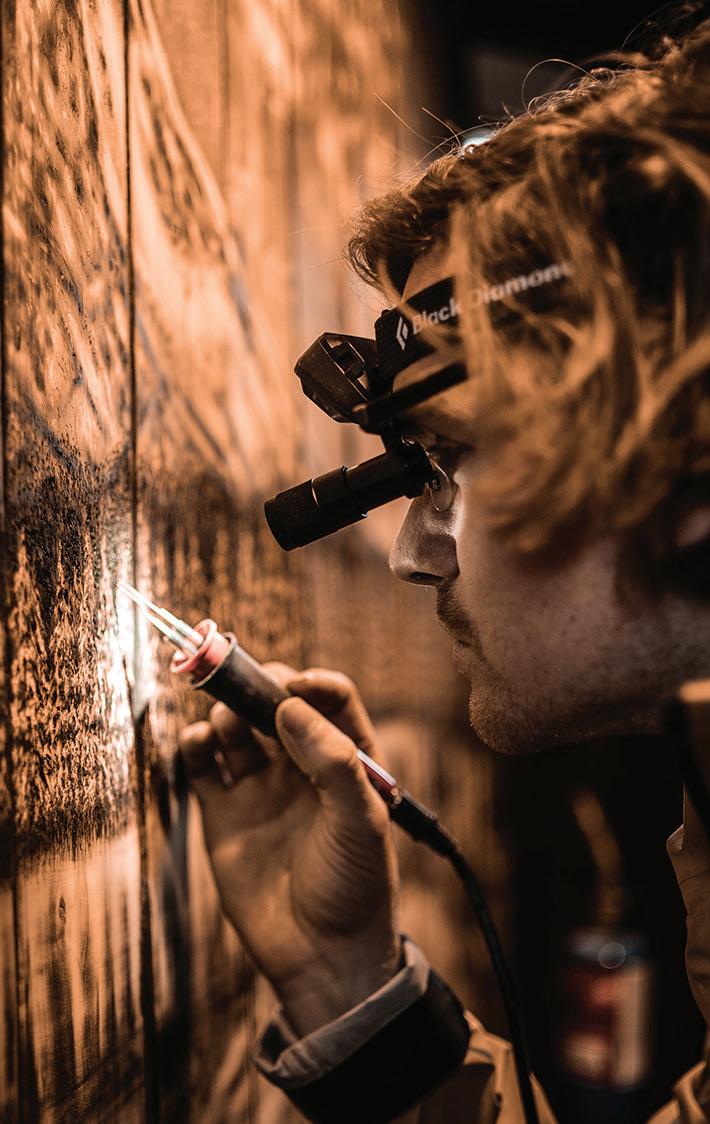
10 minute read
FEATURE
from Encore March 2020
'My Imagination Is 20/20 ' 20 /20
The Art of Aaron Shafer
by CHRIS KILLIAN
The work is done in small increments, like each step a climber takes to reach a sky-piercing peak.
To really appreciate Aaron Shafer’s most ambitious art project to date, you need to take a step back from it, and probably a few steps more, to fully appreciate how tens of thousands of miniscule nicks and notches and gently sanded burn marks come together to form the scene: a proud mountain reflected in a still lake nestled in a pine forest, the mixture of dark and light giving the impression it’s all bathed in the glow of a full moon. It’s both serene and haunting.
When Encore visited Shafer’s studio inside the garage of his Texas Township home, the piece, which he calls Meet Me at the Mountaintop, was very close to finished, the tools of his work set out in front of an oak pallet turned on end and resting atop two cinder blocks. The pallet, rescued from a refuse pile, serves as Shafer’s canvas.
He’s gone through four wood burners, three mini sanders and countless Dremel tips. Miniature magnifying glasses and sandpaper bits of several grits lie on a counter nearby, curled like dried fall leaves. He set a practice pallet on fire a few times just to determine how much heat it could stand before bursting into flames.
Shafer sets a propane torch alight, takes the flame down to low and gently brushes a plank of the pallet with the blue flame, the wood changing color from brown to nearly charred, tiny puffs of smoke rising and disappearing, the scent of singed wood coming off this hardwood canvas.
After a few delicate torch strokes and some careful sanding, an upside-down fir tree emerges, a mirror reflection of itself. The art world calls this art form “pyrography,” but watching Shafer work, wearing a pair of Ray-Ban sunglasses, his face so close to the pallet he could kiss it, doesn't feel like witnessing an artist perform his craft. It feels like seeing a magician pull something from the ether.

Brian Powers But the results are as real as wood and fire. As real as Shafer’s disability. Losing sight
If Shafer, 29, were standing next to you as you stepped back to take in the fullness of Meet Me at the Mountaintop, he couldn’t see the entirety of his work. Not like a fully sighted person could.
When Shafer was a teenager, his right eye started to develop a blind spot and tended to become cross-eyed and twitch when he would try to read. It got bad enough that he had to place a hand over his right eye to read at all.
“Things went downhill pretty quick,” he says.
At 17, he was diagnosed with Stargardt disease, a genetic eye disorder that causes the eye’s macula to degenerate, making the center of his field of vision “fuzzy” or “static,” he says. Both of his sisters have the disease as well. His most recent eye examination showed his vision to be 20/300. There is currently no cure for the disease, and treatments are few. It’s rare for those who have Stargardt disease to go completely blind, and Shafer’s condition seems to have leveled off, he says. Still, moving though life can sometimes be challenging for him. He reads words by recognizing their shapes and fills in the middle letters by recognizing the first and last few letters. His cell phone is something like a second eye, a sort of digital magnifying glass that he uses to zoom in on all sorts of things most people take for granted.
Saved on his phone’s photos folder are images of menu pages and receipts, screenshots of text messages. Text-to-voice apps also come in handy.
Shafer will look you in the eye, but he won’t see your entire face. Without you really even Eric J. Schaeffer

Top: Despite his limited vision, Aaron Shafer taught himself to be a photographer. Below: The symbolism behind Meet Me at the Mountaintop made this work a healing labor for Shafer.
noticing, he will move his eyes around, ever so slightly, so he’s looking just off-center of your face. It’s then he can see you.
“I have to fake it all the time,” he acknowledges. “I look people in the eye, but I am not really doing that.”
Still, his strategies cannot always be employed. Sometimes he walks past people he knows on the sidewalk or misgenders a


On this page: Shafer’s photography shows his elecetic interests and self-taught ability to capture people and places.


All pools built locally by Vlietstra Bros.





Built for a lifetime of relaxation…

4266 Ravine Rd. Kalamazoo, MI 49006 www.vlietstrabros.com 269-349-7779 Winter Hours: Monday - Friday: 9:00am - 4:00pm, Saturday and other times by appointment only Summer Hours: Beginning April 20 Monday - Friday: 9:00am - 5:30pm, Beginning May 2 Saturdays: 9:00am - 12:30pm
person. At times, he has mistakenly entered the wrong restroom in a restaurant, or has come out of a restroom only to have trouble finding his friends.
“It was all I could do to make my disability as invisible as possible,” he says. “I would do everything I could to avoid looking like I had a disability. I eventually got good at not being able to see well.”
People will ask him, “‘Can you see this?’” he says, “but the right question is ‘Can you process the image?’ And the answer to that is usually ‘Of course, I can.’”
Despite his disability, Shafer carries an undeniable optimism, a self-aware energy that encircles him like bark around a tree. As he says, he might be legally blind, but his “imagination is 20/20.” Becoming a photographer While in his teens, with the disease rapidly degrading his eyesight, Shafer knew the hard truth that lay on the horizon. Every month seemed to bring a change, a step backward from clear vision, like being slowly sucked into fog. He wanted to get the most out of what he had left, so he moved to Colorado, “to a beautiful place,” as he says, where he lived alone in a cabin in the mountains.
That’s where he began experimenting with his Nikon D1X digital camera. He never got to manual mode, instead using automatic features of the camera, but his initial efforts left him with mostly out-of-focus images. He kept learning, though, diving deep into what he could do with his camera, a tool that enabled him to zoom in and see things his naked eye could not, interacting with the world around him in a fuller, more meaningful way.
In a way, the techniques Shafer utilizes to see a face or an object dovetailed almost seamlessly with his passion for photography, an art form that is as much about framing and composing an image as it is about what is specifically captured in the picture.
“I have a relationship with my camera that 99 percent of people don’t,” he says. “Most people see a camera as an extension of their eye. For me, it’s like another eye.”
In a very real way, his disability helped contribute to his almost instinctual ability to frame and compose pictures, he says, because although the center of his vision is dark, the perimeter is clear.
“I am always seeing and noticing the corners of what I look at,” he says. “It induces a compositional way of thinking. The most important parts of a picture are the corners. “Photography is quick composition. You have to know what you want your picture to look like. It’s the science of how your eye interacts with a two-dimensional thing. Where does your eye go first? Where does it go second? A well-composed picture is pleasurable to the eyes, like watching the balls in a pinball machine move around in circles.”
As his skills grew, so did the diversity of his photography. With no professional training, Shafer has captured undeniably professional photos of musicians playing live, the creamy arm of the Milky Way, the grandeur of the American West, ethereal urban landscapes, and skateboarders and snow-skaters (who use a kind of mini-snowboard like a skateboard) hovering in mid-air.
From 2014 to 2015, Schafer traveled from New York City to Los Angeles with a Kalamazoo-based production team to shoot still photos during the filming of Dirty Waters II, a film distributed across the country. During February and March 2016, he traveled across Quebec with Ambition Snowskates, creating content for an article released by Red Bull. He’s spent the last few years growing his portfolio, collaborating with musicians, dancers and models and running a photography business, Aaron Shafer Photography, in downtown Kalamazoo. Eric J. Schaeffer

See Aaron Shafer’s Art
What: The Healing Fire exhibit
When: April 3, 5-9 p.m., during Art Hop
Where: Consumer’s Credit Union, 125 S. Kalamazoo Mall
(This was the location for the exhibit at press time, however, due to construction, the site for Shafer’s exhibit may be changed. Visit kalamazooarts.org or check the Art Hop brochure for an updated location.)
On Instagram: @TheHealingFire His real passion now, however, is his pyrography. Perhaps it’s the excitement of something new, of seeing the stunning results of another type of fine art he’s had to teach himself how to create, he says.
“I’d like to make a living doing this kind of art,” he says. “I put my heart and soul into what I do.”
And his vision too. Recognition and reward are not what Schafer is after. During his years as a fine artist, he has seen success in the genres he’s thrown himself into, due to his persistence and patience with himself and his disability. He will be showcasing Take Me to the Mountaintop at the April 3 Art Hop, which is dedicated to using found and repurposed objects in recognition of Earth Day.
Viewers of Shafer’s work would never know that the artist has Stargardt disease, or a visual disability of any kind. He didn’t plan it that way. It is what results when a person’s drive to get the most out of what they have supersedes any pitfalls or roadblocks in their way. Sometimes he can negotiate around them, and sometimes he bowls right through them.
“It’s gotten to the point where I don’t care how broke I am. This is what I want to do,” he says. “I have work to do — my work, my craft, my vision of becoming the best I can be. That’s what I’m devoted to — the process of finding out what I am capable of and what I can become.”
LFW Office Solution has created a program that will allow your company to upgrade your current printer fleet.


Our program is very simple: Receive as many printers as needed, purchase toner from us under the TMP system for two years, and you own the printers. LFW will make sure your company is printing at peak performance. Contact us today for your evaluation. bill@lfwofficesolutions.com Contact us today: For your rewards card, place 4 orders and receive a 30% discount on your 5 order.









